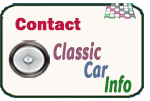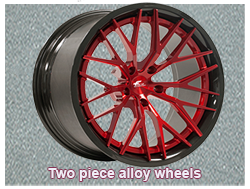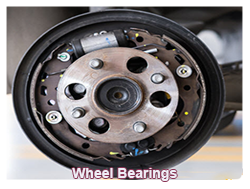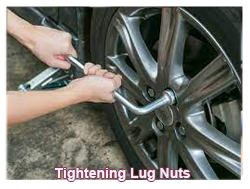
TD WHEEL: Describes a form of a safety wheel incorporating a td rim with run-flat properties that will allow further driving of up to twenty miles at a maximum speed of 40 mph in the event of a puncture. The tire's reinforced bead toes are held firmly in place by the grooves, preventing the deflated tire from sliding into the rim well.
THREE-PIECE ALLOY WHEEL: Describes a forged alloy wheel fitted with a wheel spider with a divided rim consisting of an outer and an inner rim well bolted to the spider.
Describes a forged alloy wheel fitted with a wheel spider with a divided rim consisting of an outer and an inner rim well bolted to the spider.
TIE ROD ENDS: Describes a variety of ball joint that transfers the movements of the steering wheel to the wheels.
TWO-PIECE ALLOY WHEEL: Describes a car wheel consisting of the rim and the wheel disc or spider bolted together.
VENTILATION SLOT: Describes a series of gaps in the wheel disc that allows airflow assist brake cooling.
WELL-BASE RIM: Describes a type of wheel rim with a central recess where one side of the tire bead can be gently inserted, with the opposite side requiring slightly more force to allow it to be fitted or removed. Well-base rimmed wheel rims are the most commonly used on passenger cars due to their ease of installation.
WHEEL BALANCING: Describes a professional procedure that ensures that the wheel's weight is distributed evenly to improve performance and cut tire wear.
WHEELBASE: Describes the total distance between the front and the rear axles on a vehicle.
WHEEL BEARINGS: Describes the ball bearings used in drive shafts as well as taper roller bearings used in driven hubs.
WHEEL BOLT: Describes a type of bolts that can be screwed into threaded holes in the wheel hub.
WHEEL BOLT HOLE: Describes the insert through which bolts are inserted to secure the wheel to the hub.
WHEEL BRACE: Describes a type of cranked socket wrench used to tighten or release wheel nuts.
WHEEL CENTRE BORE: Defines the diameter opening in a disc allowing the axle hub to protrude outwards for the vehicle's wheels to be attached.
WHEEL COVER: Describes a type of hubcap that covers the entire wheel but not the tire.
WHEEL CYLINDER: Describes a small cylinder attached to each wheel brake filled with brake fluid that will exert gradual hydraulic pressure on the brake shoes against the brake drums slowing down the vehicle.
WHEEL CYLINDER: Describes the part of the hydraulic brake system that applies pressure to the brake shoes through the master cylinder.
WHEEL DISC: Describes the part of the wheel that connects the rim to the hub.
WHEEL LUG BOLT: Describes the bolts used to fasten the wheel to the hub.
WHEEL MOUNTING: Describes the unit that attaches the wheel to a hub.
WHEEL NUT: Describes one of several nuts that hold the wheel and tire assembly on the car and are screwed on the studs.
WHEEL OFFSET: Details the dimensions from the centre of the rim to the outside face.
WHEEL RIM: Describes the outer part of the wheel on which the tires are mounted.
WHEEL ROTATION:  Describes the worthwhile practice of changing the position of wheels around to compensate for unequal tire wear and increase tread life.
Describes the worthwhile practice of changing the position of wheels around to compensate for unequal tire wear and increase tread life.
WHEEL TRIM RIM: Describes a recessed ring produced in either stainless steel or chrome that improves older steel wheels' appearance.
UB5


